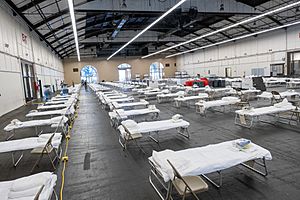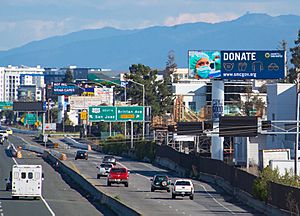COVID-19 pandemic in the San Francisco Bay Area facts for kids

|
|
| Disease | COVID-19 |
|---|---|
| Virus strain | SARS-CoV-2 |
| Location | San Francisco Bay Area, California, U.S. |
| First case | Santa Clara County |
| Arrival date | Error: Invalid time. |
| Origin | Wuhan, Hubei, China |
| Confirmed cases | Lua error in Module:Medical_cases_data at line 64: attempt to index field 'wikibase' (a nil value). in 9 counties |
| Recovered | Lua error in Module:Medical_cases_data at line 64: attempt to index field 'wikibase' (a nil value). in Lua error in Module:Medical_cases_data at line 64: attempt to index field 'wikibase' (a nil value). counties |
|
Deaths
|
Lua error in Module:Medical_cases_data at line 64: attempt to index field 'wikibase' (a nil value). in 9 counties |
The San Francisco Bay Area, home to big cities like San Jose, San Francisco, and Oakland, was one of the first places in the U.S. to be hit by the COVID-19 pandemic. The very first case of COVID-19 in the area was found in Santa Clara County on January 31, 2020.
Later, it was discovered that a person in Santa Clara County, who had not traveled abroad, died from COVID-19 on February 6. This was the earliest known death from the virus in the United States. This sad discovery showed that the virus was already spreading among people in the community before anyone even knew about it. This article talks about the pandemic's impact on 13 counties in and around the Bay Area.
Local leaders in the Bay Area took some of the first big steps in the U.S. to slow the virus. The first mandatory stay-at-home order in mainland America started in the Bay Area on March 16 and 17. This order meant that nearly 6.7 million people had to stay home until mid-May. Many believe that these early actions helped prevent the virus from spreading as much as it did in cities on the East Coast.
The pandemic caused many businesses to close, leading to a lot of people losing their jobs. This also changed local government budgets from having extra money to having big debts. The pandemic made schools switch to distance education (learning from home) and many businesses, especially in tech, started using remote work (working from home). A positive change was that the air quality around San Francisco Bay got better because there were fewer cars on the roads.
Contents
How Many People Were Affected by COVID-19?
Lua error in Module:Medical_cases_data at line 64: attempt to index field 'wikibase' (a nil value). Lua error in Module:Medical_cases_data at line 64: attempt to index field 'wikibase' (a nil value).
Even though California and China have strong connections through business and travel, the Bay Area did not have as many hospitalizations or deaths as first expected. Its numbers were better than many East Coast cities. Experts think this might be because the Bay Area took early steps like social distancing (keeping people apart). Other reasons could include fewer people living very close together, many people using cars instead of public transport, good weather in February, and even the San Francisco 49ers losing the Super Bowl LIV, which meant fewer big celebrations.
As of May 26, 2020, the nine Bay Area counties plus Santa Cruz County had a total of 13,060 confirmed cases and 434 confirmed deaths from COVID-19. Alameda County had the most cases and deaths in Northern California, followed by Contra Costa County.
Some counties shared details about where cases were found. In Alameda County, Hayward had the highest rate of infection per person. Oakland had the most total cases. In San Mateo and Santa Clara counties, San Mateo and San Jose had the highest number of cases, respectively.
As of May 17, 2020, the North Bay counties of Marin, Napa, and Sonoma reported a total of 345 people who had recovered from COVID-19. Other Bay Area counties did not track recoveries as closely. The University of California, San Francisco (UCSF) is studying how people recover over several months.
Who Was Most Affected by COVID-19?
The Hispanic population in the Bay Area was hit harder by infections. For example, in East San Jose, poor neighborhoods with many Latino residents accounted for 34% of Santa Clara County's first COVID-19 deaths. This is a higher percentage than their share of the total adult population (23%). Many people in these neighborhoods could not work from home.
Filipino Americans in the Bay Area were also greatly affected, making up most cases in San Mateo County, California. In San Francisco, about 40% of Hispanic residents were confirmed to be infected, compared to 15% of the general population. The Mission District, which has many Latino residents, had the highest number of cases of any neighborhood.
Some local outbreaks happened in workplaces and care homes. For example, over 130 people tested positive at the Tesla factory in Fremont. At the Lusamerica Foods fish packing plant in Morgan Hill, 38 people got sick. In San Francisco, four residents died at the Central Gardens nursing home. In Vallejo, more than 130 people were infected and eleven residents died at the Windsor Vallejo Care Center.
Experts believe the actual number of people infected was much higher than the confirmed cases. This is because there were not enough tests available, especially early in the pandemic. For example, Santa Clara County set up testing sites in San Jose, but they were not used to their full capacity. This was partly due to language barriers for Spanish and Vietnamese speakers.
Scientists also tried to find out how many people had already been infected without knowing it. A study from Stanford University in April estimated that up to 54,000 people in Santa Clara County (about 2.8% of the population) had been infected. At that time, only 1,000 cases were confirmed.
In October 2020, Santa Clara County started checking wastewater for the SARS-CoV-2 virus. This helps them track the virus's spread in the community.
How Did the Pandemic Progress?

First Cases of COVID-19
Some people thought that COVID-19 might have been in the Bay Area as early as December 2019. Scientists are still looking into this. As of February 14, 2021, the earliest known cases in Santa Clara County were dated to January 27, 2020.
On January 31, 2020, the Centers for Disease Control and Prevention (CDC) announced the first confirmed COVID-19 case in the Bay Area. This was the seventh case in the United States. It was a man in Santa Clara County who had recently traveled to Wuhan, China. He recovered at home. On February 2, a second case was confirmed in a Santa Clara County woman who also traveled to Wuhan. These two cases were not connected.
On February 6, 2020, Patricia Dowd, a 57-year-old woman from San Jose, died from COVID-19. She had not traveled recently. She had been very sick with the flu in late January, then seemed to get better. She worked from home and then suddenly died. An autopsy in April found that COVID-19 caused her death. Her case showed that the virus was spreading in the community without being noticed, possibly since December 2019.
On February 26, 2020, a case was confirmed in Solano County where the person had not traveled or been in contact with anyone known to have the virus. This was the first case of "community transmission" in the U.S. The UC Davis Medical Center had suspected it was COVID-19 and asked the CDC to test for it. The CDC first said no because the person didn't fit their testing rules at the time. But the person was finally tested, and the results came back positive.
After this case, the CDC changed its rules for testing people for SARS-CoV-2. On February 28, they sent out new guidelines for healthcare workers.
The first case of the Omicron variant found in the United States was also in the Bay Area. A person in San Francisco returned from South Africa on November 22, 2021. They started having mild symptoms on November 25 and were confirmed to have COVID-19 on November 29. This person had been vaccinated but had not received a booster shot.
COVID-19 Cases Over Time by County

